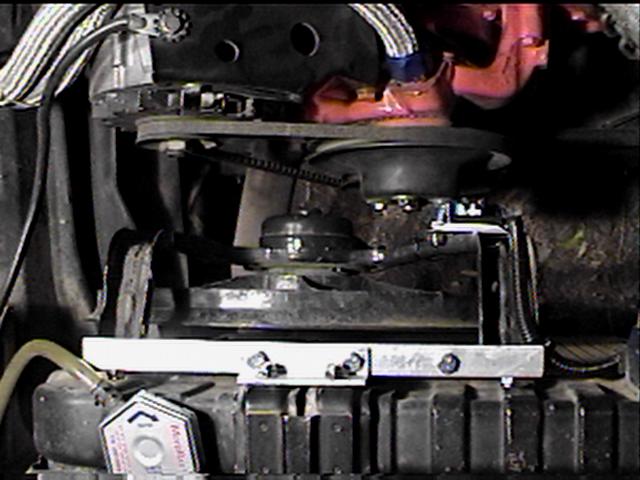
I thought this was a good project to do after a friend had his fan explode in his 1965 Buick Riviera
Gran Sport. One blade sliced through the hood, (the recently repainted hood!!) others cut hoses
and automatic transmission lines, one stuck in the battery, a couple went into orbit, and the water
pump broke. It wasn't pretty, and the car was flat-bedded home. It might be a Real good
idea to closely inspect your 30 - 40 - 50 year old fan hub for stress cracks. Not being paranoid or
anything, I promptly tossed out the OEM fan in the 1965 GMC Suburban in favor of an electric cooling
fan. A nice benefit is the truck is quieter without the roaring fan.
I don't even know what the fan I used came from, and it doesn't really matter. Just find one that fits at
a good junkyard. (the idea here, is cheap) I used a waterheater upper element thermostat for the control.
See the schematic below.
Update: I found out the fan came from a Chevy Citation. We don't know what year, but the good news is it's
from a Chevy! I didn't commit sacrilege after all!

I mounted the fan offset because the water pump's nose was too close for comfort. The offset keeps the motor
apart from the pulley's hub. I used aluminum angle for the mount, and attached it to the radiator cradle
with 1/4 x 20 bolts and aircraft locking nuts. I kept the bolt heads above the top of the tank, and
behind the rubber mounting cushion. More angle underneath keeps the fan's bottom leg solid. I used an 'L'
shaped bolt in the 1/4" thick bottom brace below.
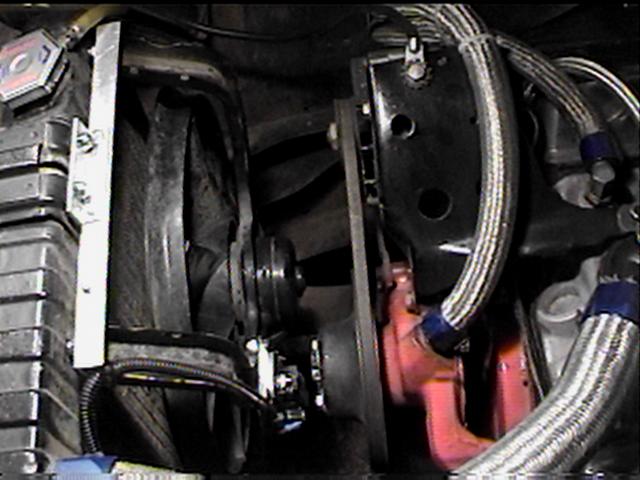
Another view of the fan. This is a 15" job that moves lots of air. There is about 4" of dead space on the
driver's side of the radiator, but it seems to cool the 400 okay. A flatter "pancake" fan would
fit more centered than this one does. But... I just couldn't beat the price of this one ~ i.e. FREE.
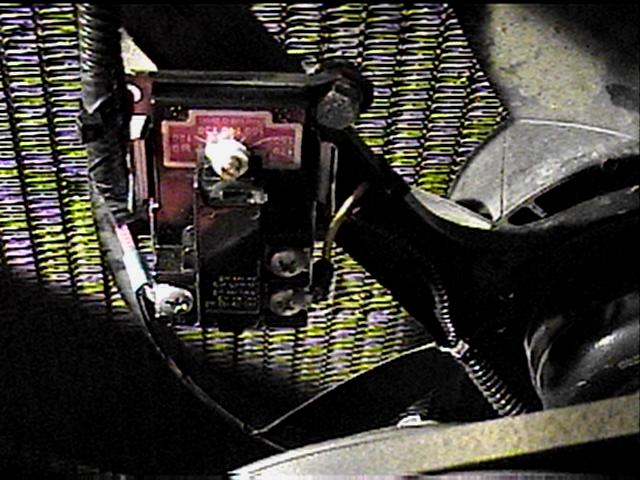
The waterheater thermostat hanging from the fan's mounting arm. Since it operates from the air temperature
here, I set it lower than the water temp by a wide margin. I set it at 140 degrees. Depending on
where it ends up, it will take experimenting to make the fan start at the right time.
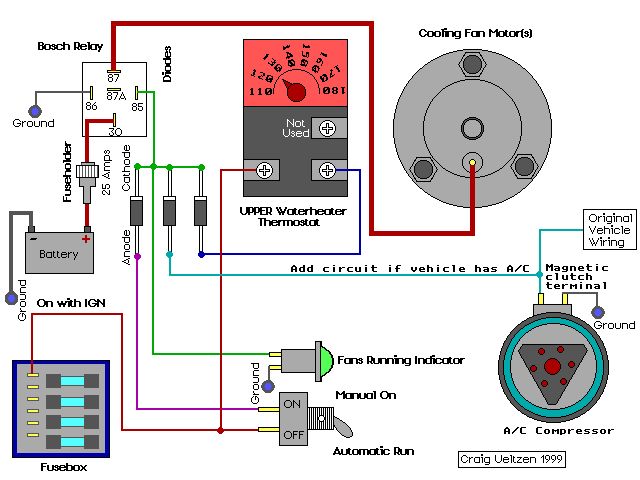
The diodes aren't critical. Radio Shack 1 amp rectifiers will work fine. The diodes and relay isolates the
indicator light from the fan's motor, and the two control circuits. (Thermostat switch and manual-on
switch) This keeps the light from coming on when the fans spins in the wind at freeway speeds and
generating power for the bulb. That way, it lights only when the fan is actually turned on. If you have
air conditioning, just add a third diode with it's cathode (banded end) towards the relay's 85 terminal,
and run the wire from it's anode to the compressor's clutch line. The fans will then run with the A/C
compressor to keep air moving through the condenser.
You must use a waterheater's UPPER thermostat. A lower T'stat will work just the opposite. The waterheater's
element is ON and heats the water until it reaches the set temp. then turns OFF. You need the fans turning
ON at the set temperature, not OFF. In a waterheater, an upper T'stat heats with the top element, then
switches to the lower T'stat. This circuit uses half the switching part of the upper thermostat. The
waterheater upper T'stat is only about $12. Your other option for controlling cooling fans, is an expensive
automotive fan control thermostat.
Set aside the reset switch part of the thermostat. It isn't needed here. The thermostat isn't switching
the heavy fan current, only the relay.
It will take experimenting to get the temp set right. I set mine to 140, and it will kick on in town,
and turn off when I'm above 40 - 50 MPH. (after a while) There's enough air moving through the radiator
after you get moving to negate the need for the fan running.
Don't wire cooling fans so you can disable them. They need to be controlled by the engine's temperature.
If you forget to watch the temperature guage, the engine will boil over!!
Beware when working on the engine. The fan may turn on at anytime the key is on.
Fingers are handy for doing these projects. Keep them.
If you have an engine with heat problems after it's shut down, (boiling carb, etc.) change the IGN feed
wire going to the thermostat to battery power. They will run after the engine is stopped, and everything
will cool down fast with the running fan(s). They will turn off after a while when the thermostat reachs
it's set temp. Just have a big battery! They may run for 10 -15 minutes. Leave the manual-on switch wired
to IGN power in case you forget and leave it on. That way, only the T'stat can control them after the
Ignition key is turned off.
~ 6066 GMC Trucks ~ 6066 GMC Trucks ~ 6066 GMC Trucks ~ 6066 GMC Trucks ~ 6066 GMC Trucks ~ 6066 GMC Trucks ~ 6066 GMC Trucks ~ 6066 GMC Trucks ~
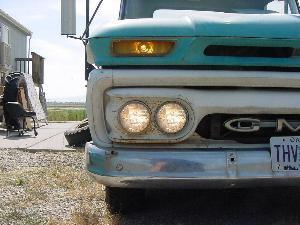 |
Lighting & Electrical Projects
|
|
|
|
|
~ 6066 GMC Trucks ~ 6066 GMC Trucks ~ 6066 GMC Trucks ~ 6066 GMC Trucks ~ 6066 GMC Trucks ~ 6066 GMC Trucks ~ 6066 GMC Trucks ~ 6066 GMC Trucks ~
© 2000-2008 6066 GMC Trucks. Last Updated July 29, 2008.